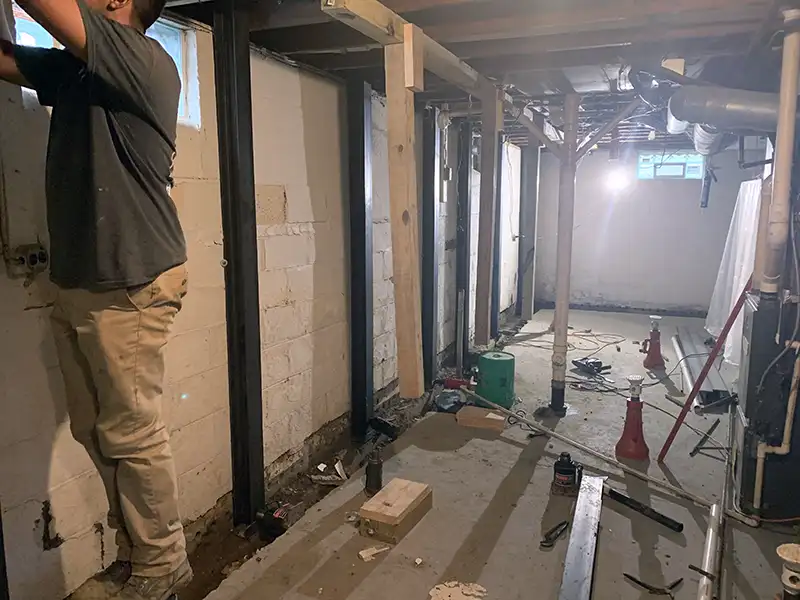Foundation Repair
Foundation repair involves a systematic approach utilizing pier supports and steel I-beams to address structural integrity issues. Pier supports, such as steel and helical piers, are embedded deep into stable soil or bedrock to bear substantial loads. Steel I-beams counteract lateral pressure, preventing wall bowing. Methods vary; however, steel and helical piers offer minimal disruption. Proper soil assessment is vital for effective installation. Regular inspections and drainage maintenance guarantee lasting results. Addressing cracks and rebuilding compromised walls may be essential, driven by thorough soil analysis and moisture control measures for durability. Learn more about verifying your foundation remains stable and secure.
Key Points
- Foundation reinforcement includes installing pier supports and steel I-beams for stability and load distribution.
- Regular inspections and proper drainage are crucial for maintaining foundation longevity.
- Crack repairs involve injecting sealants and implementing soil stabilization to prevent future issues.
- Wall rebuilds use reinforced concrete and steel to address severe structural damage.
- Structural assessments and soil compaction techniques are essential for preventing settlement and ensuring foundation integrity.
Foundation Reinforcement
Foundation reinforcement often involves the use of pier supports and steel I-beam installation to enhance structural stability.
Pier supports, typically installed deep into stable soil or bedrock, provide a solid foundation that can bear substantial loads.
Steel I-beams are installed to counteract lateral forces, preventing wall bowing and ensuring long-term integrity.
Pier Supports
Pier supports are an important solution for reinforcing compromised foundations, providing robust stability and long-term reliability. They come in various pier types, each tailored to specific soil conditions and structural needs. Common types include steel piers, helical piers, concrete piles, and poured concrete piers. Each type has distinct advantages, such as the deep penetration of steel piers into stable soil or bedrock, offering unparalleled support.
Installation methods vary by pier type. Steel and helical piers are driven or twisted into the ground, minimizing excavation and disruption. Concrete piles and poured concrete piers, on the other hand, require more extensive excavation and curing time.
Proper soil assessment is vital before choosing a pier type to guarantee compatibility and effectiveness.
Maintenance tips for pier supports include regular inspections to detect any signs of shifting or settling. Guaranteeing proper drainage around the foundation helps to maintain soil stability and prevent water-related issues.
Cost factors depend on the pier type, installation complexity, and the extent of foundation damage. While initial costs may be significant, the long-term benefits of reinforced stability and structural integrity make pier supports a worthwhile investment.
Steel I Beam Installation
When it comes to addressing significant foundation issues, one of the most effective reinforcement methods is the installation of steel I-beams. These beams offer several benefits including high strength, durability, and effective load distribution. They can stabilize bowing or cracked walls by evenly transferring the load from the compromised foundation to the steel beams.
Installation techniques involve precise steps. Initially, a trench is excavated along the foundation wall. Then, the steel I-beam is placed vertically, spanning from the basement floor to the joists above. Proper anchoring at both ends guarantees the beam remains rigid and effective in redistributing loads.

Design considerations are critical for successful installation. Engineers must assess the foundation’s condition, load-bearing requirements, and the placement of the beams to maximize effectiveness. They also need to confirm that the installation complies with local building codes and standards.
Maintenance practices include regular inspections to check for any signs of rust or displacement. Applying protective coatings can prevent corrosion, thereby extending the lifespan of the steel beams.
Wall Rebuild
In the domain of foundation repair, wall rebuilds often become necessary when damage extends beyond mere cracks and compromises the structural integrity of the building. This process is vital to restore foundation stability and guarantee the long-term safety of the structure.
The first step involves a thorough soil analysis to understand the underlying causes of wall failure. Different soil types react differently to moisture, and expansive soils can exert significant pressure on foundation walls.
Selecting appropriate repair materials is paramount. Reinforced concrete, steel reinforcements, and masonry units are typically used, depending on the extent of damage and the specific requirements of the building. Proper materials guarantee that the rebuilt wall can withstand future loads and environmental conditions.
Effective drainage solutions are essential to prevent future issues. Poor drainage can lead to water accumulation around the foundation, exacerbating moisture problems and increasing hydrostatic pressure on walls. Installing proper drainage systems, such as French drains or sump pumps, helps control moisture levels and directs water away from the foundation.
Moisture control is another vital factor. Implementing measures like waterproofing membranes and sealants can protect the new wall from water infiltration. Guaranteeing that gutters and downspouts are functioning correctly and directing water away from the building is also vital.
Crack Repair
Although often overlooked, crack repair is a significant aspect of maintaining a building’s structural integrity. Cracks in the foundation can signal deeper issues that, if neglected, may escalate into considerable structural problems. The process begins with a thorough foundation inspection to identify the extent and cause of the cracks.
Crack sealing is the primary method used for addressing minor repairs. This involves injecting materials like hydraulic cement or polyurethane foam into the cracks to prevent water infiltration, effectively enhancing the building’s waterproofing solutions. Proper sealing guarantees that moisture doesn’t exacerbate the damage, which is fundamental for maintaining the foundation’s longevity.
However, sealing alone isn’t always sufficient. Soil stabilization plays an important role in crack repair. Unstable soil conditions can lead to foundation settling, causing cracks to reappear. Techniques such as soil injection or the use of helical piers can stabilize the soil beneath the foundation, thereby preventing future cracking.
Waterproofing solutions must also be considered. Post-repair, it’s crucial to apply measures that prevent water intrusion, such as installing exterior drainage systems or applying waterproof coatings to the foundation walls. These steps help protect the foundation from hydrostatic pressure, a common cause of cracks.
Structural Support System Repair
Following crack repair, addressing the structural support system is imperative to guarantee long-term stability. A thorough foundation stability assessment should be conducted to identify any underlying issues that could compromise the integrity of the structure. This involves a detailed evaluation of soil conditions, moisture levels, and existing support mechanisms.
Foundation inspection methods play a vital role in this assessment. Professionals will use various techniques to detect weaknesses, including visual inspections, load tests, and advanced imaging technologies. These methods help pinpoint areas needing immediate attention, ensuring that the foundation’s overall health is accurately gauged.
Soil compaction techniques are often employed to enhance the foundation’s support. By compacting the soil around and beneath the foundation, the risk of future settlement is minimized. This process involves the use of specialized equipment to increase soil density, thereby providing a more stable base for the structure.
Moisture control solutions are also essential in maintaining foundation stability. Excess moisture can lead to soil expansion or contraction, causing the foundation to shift. Installing effective drainage systems, waterproofing the foundation walls, and using vapor barriers can help control moisture levels and prevent related problems.
Structural integrity evaluation is the final step in ensuring a robust support system. This includes examining the load-bearing elements, such as beams, columns, and piers, to confirm they’re capable of supporting the structure’s weight.
Any deficiencies found during this evaluation must be addressed promptly, whether through reinforcement or replacement.


